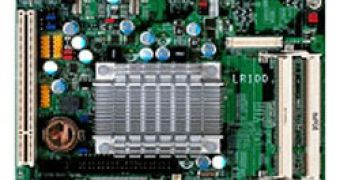LR100-N16M, the new mini-ITX motherboard from DFI, is a two-chip platform, which takes up about 40% less space than three-chip solutions and provides a higher per-watt performance than any previous Intel Atom-based platforms. The board integrates two chips, namely the Intel Atom N450 and the Intel 82801HM I/O Controller, and uses a fanless design for low power consumption.
The motherboard will be usable in POS, Kiosk, medical equipment embedded purposes and applications that need a stable revision-controlled platform (gaming and industrial control automation for instance). This implies that the LR100-N16M will assist in the automation of transaction processing and collection of marketing data, improving work flow and the overall experience of customers.
The motherboard uses the aforementioned 45nm Hi-K technology Intel Atom N450 processor, which runs at 1.66GHz and has a 5.5W TDP and a 667MHz FSB, as well as an eight-way L2 cache memory of 512kb. The product itself is equipped with dual PCI Express Gigabit LAN controllers and 2GB of single-channel DDR2 system memory running at 667 MHz. Furthermore, the board's integrated GMA 3150 graphics controller supports DirectX 9.0c Pixel Shader 2.0 and has both VGA and LVDS interfaces, allowing for dual-independent display possibilities.
Further specs of the motherboard include four serial COM ports, three Serial ATA (SATA) ports with speeds of up to 3GB/s, a CompactFlash socket and no less than ten USB 2.0/1.1 connectors. The embedded mini-ITX motherboard also has one PCI Express x1 and one PCI slot for expansion. Finally, the LR100-N16M features high-definition audio support with S/PDIF I/O interface.
The product achieves its low-power consumption thanks not only to the N450 and Intel 82801HM I/O Controller Hub, but also to the ACPI 3.0 Power management based on Intel's SpeedStep technology. Combined with the overall capabilities, it will go very well in any of the aforementioned setups, such as POS (Point of Sale) terminals used in everything from malls to warehouses.

 14 DAY TRIAL //
14 DAY TRIAL //